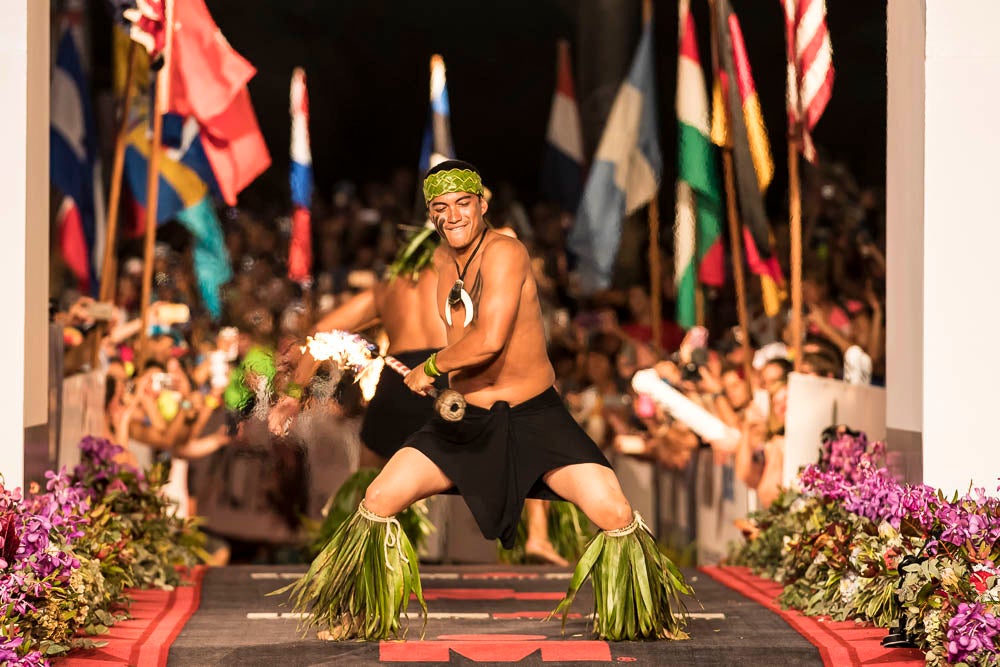Characters of Kona: The Last Finisher 2018

Hawaiian dancers officially close out the day of racing. Photo: Paul Phillips/Competitive Image
Some places hold a special meaning that can only occur at the perfect intersection between time and space. On almost any other day, a stretch of road can be just a stretch of road. Even an hour before or an hour after, a place with infinite importance can just be a spot that sits there waiting, unused. It’s all about timing, and sometimes that timing takes years to ripen before it’s ready to transform from something mundane to something sublime.
Since the Hawaii Ironman began back in 1978, it was supposed to be about taking something hard and making it harder. It was about seeing who could do the craziest thing in a place that was hot, uncomfortable, and not conducive to sports: “A 2.4-mile swim is hard, but let’s add a 100-mile-plus bike. Both of those seem tough, so let’s add a marathon at the end.” Those 15 original “Iron Men” (though there were women) raced those distances because they seemed unreasonably difficult. For them, there was little emphasis on who was first and what his or her time was. The point was that they finished the thing and could count themselves among the craziest of the crazy. That was how it began.
But of course things change. In the years that followed, the number of participants in the Hawaii Ironman went from less than 20 to the hundreds. A Sports Illustrated story created the first big leap in participation—it seems that more people wanted to try something that seemed impossible to many and stupid to so many others. Another huge wave of popularity crashed upon the Hawaii ironmen and women in the ‘80s when footage of a woman crawling, nonsensically toward some arbitrary finish line was beamed into the homes of millions of people. Julie Moss had gone so deep into crazy that she was fighting just to survive her self-inflicted mission. Something that was at one moment so sublime had become something almost grotesque. But for many, the images resonated and became sublime again.
Since then, the Ironman evolved further. It went from something crazy hard that people would make even harder to something that people wanted to try to control. As iron-distance races started popping up in different places, the emphasis went from finding the toughest, most uncomfortable situation to test oneself to trying to see who was faster, who could control the situation the best, to see who could prepare for every possibility and make sure that nothing went wrong. For many, it went from trying to test one’s mettle when everything went off the rails to desperately trying to make sure that nothing could go wrong in the first place. It became a battle not with the course or the conditions, but a battle to tick off boxes before ticking off the big box at the end.
But for others, it was still about getting themselves to the toughest place possible to see what they were made of. For Ian Isaac, it was a 20-year trek to get himself to that spot. Isaac first started hearing the stories back in 1997 when he was training in Brisbane, Australia, and his teammates talked about some legendary place that a triathlete could only dream of.
Isaac isn’t the fastest triathlete. He’s less of the new, pointy-end, fast on flat Florida ironpeople and more of the 21-plus-hours, 1978-Ironman-class of triathletes. He loves the sport so very much and it shines through as he talks about his trip to slowly get from Ironman starter to Hawaii Ironman Finisher.
Isaac would likely only have only one shot: Because he wasn’t all that fast, it would be a matter of simply willing himself to the Big Island. He earned his Kona slot via the legacy program that rewards triathletes who have finished more than 12 Ironman events and are still actively racing with a chance at a lottery position.
In 2017, he traveled to Kona and spent the days—like so many others do—taking in the sites of these special places that are just everyday spots for most of the year. He wanted to see in-person the legendary parts of the Hawaii Ironman course like the Queen K, the Hawi turnaround, the Natural Energy Lab, and finally Palani Road before making a pilgrimage to the most holy of holies, Ali’i Drive. His intention in visit those sites wasn’t to prepare for every possible outcome, it was just to soak in what was special—maybe get a whiff of how a busy street corner could transform itself on another day into something monumental.
Days later, as Isaac stood on the beach, moments before the cannon would go off, looking around at the scene surrounding him, hearing the sound of the helicopters in the air, he would take it all in; after all he had waited and worked 20 years to get to this place.
Sixteen hours, fifty-four minutes, and fifty-two seconds later, 54-year-old Ian Isaac, carried home by the history, the craziness, the challenge, and eventually the crowd would cross the line as the person who had been out battling longer for anyone else on that day. The stuff that happened in between was the stuff he had been hoping to find—consciously or not—for the last 20 years. But that stuff was just for him. For Isaac, when he crossed the line at that exact time and that exact place, he understood the unspoiled version of what the original Hawaii Ironman was meant to be and everything else simply lifted away.